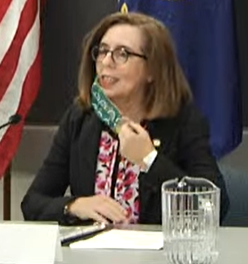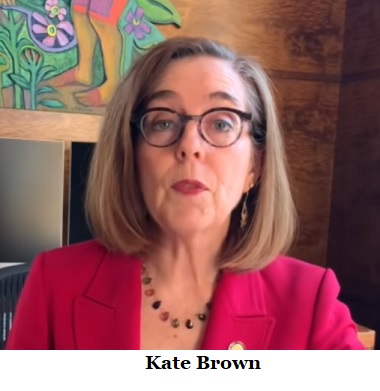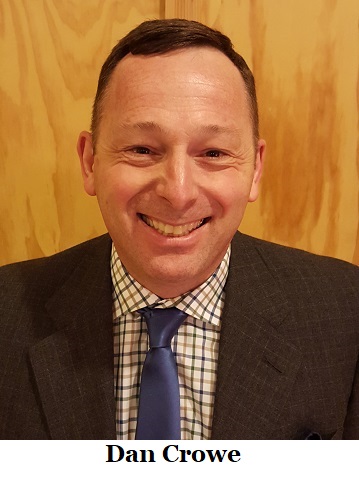
On this day, September 9, 1938, installation of the pioneer statue atop the Oregon Capitol Rotunda began. It took several days.
Also on this day, September 9, 1998 Keiko the killer whale star of the movie
Free Willy, left Oregon. He was flown to a sheltered bay in Iceland when Jean-Michel Cousteau's Ocean Futures Society took over his care. Part of his training included swimming in the ocean outside the bay. Keiko disappeared on one of these excursions. He eventually turned up 870 miles away off the Norwegian coast.
Also on this day, September 9, 1942, A Japanese float plane, launched from a submarine, made its first bombing run on a US forest near Brookings, Oregon. Japanese planes drop incendiary bombs on Oregon in an attempt to set fire to the forests of the Northwest. The forests failed to ignite, but Pacific Coast citizens stepped-up their blackout drills in preparation for future Japanese raids.
Also wants special licensing required to sell
Governor Kate Brown today received recommendations from the Vaping Public Health Work Group to address the epidemic of vaping-related illness and youth vaping in Oregon. According to the Oregon Health Authority, youth e-cigarette use jumped 80 percent between 2017 and 2019.
The work group’s membership includes doctors and experts in pulmonology, pediatrics, and public health, as well as state legislators and state agency representatives. Over the course of the last eight months, they met to discuss the health risks of vaping and making public policy recommendations for long-term solutions.
“In the middle of a worldwide pandemic, it might be easy to forget that less than a year ago, we faced a nationwide epidemic of vaping-related illness,†said Governor Brown. “Now, though, as we are facing the spread of a disease that attacks our respiratory systems, it’s even more important that we take steps to protect the health and safety of Oregon’s youth, who have been using vaping products at increasingly high rates.â€
“I would like to thank the members of this work group for continuing this important work even as many of them were also on the front lines responding to the COVID-19 pandemic. Based on
these recommendations, we can take long-term steps to ensure that we do not see another outbreak of vaping-related illnesses and deaths, as we did last summer.â€
Among the health experts on the Vaping Public Health Work Group is Dr. Brian Druker of the OHSU Knight Cancer Institute, a pioneer in the field of precision medicine whose research has helped to revolutionize cancer treatment. Dr. Mary McKenzie, the Director of Pulmonology at Legacy Health, also brought her direct experience working with patients with vaping-related lung injuries to the panel.
The recommendations of the Vaping Public Health Work Group include:
Banning the use of flavored e-cigarettes and other flavored vaping tobacco products
Flavored products disproportionately target Oregon youth, young adults, and communities of color. Banning these products is an evidenced-based approach to prevent Oregonians from becoming addicted at a young age. Flavored products are market-entry products, with 75% of Oregon youth choosing flavored products, compared to only 18% of adults over the age of 25. For decades, the tobacco industry has also targeted people with low incomes and Black, Indigenous, and People of Color (BIPOC) communities with marketing campaigns, leading to harmful health impacts for those communities.
Banning harmful additives, requiring ingredient disclosure for cannabis vaping products, and establishing standards for documentation and verification
Because cannabis is a new industry, additional regulations are needed to ban harmful additives, such as vitamin E acetate, which were strongly linked to the outbreak of vaping-related illness last summer. Many illnesses were linked to products purchased at licensed retailers. Other additives may also be harmful. Ingredient disclosure will help consumers and regulators verify what additives are in cannabis vaping products. In addition, there are not yet established federal or state safety standards for the safety of additives when combusted or vaporized.
Increasing the price of tobacco and nicotine products, including e-cigarettes, through tax and non-tax approaches
As youth have less spending money than adults, they are generally price-sensitive consumers. Raising the price of tobacco products has shown to be the most effective way to reduce youth use, reducing overall tobacco-related health care costs and deaths. In general, For every 10% increase in the price of e-cigarettes, use can drop by as much as 20%, depending upon the type of e-cigarette. E-cigarettes and other inhalant delivery systems are not currently taxed in Oregon.
Banning online and phone sales of e-cigarettes and other vaping products
Requiring in-person sales of vaping products will help prevent the sale of vaping products to underage Oregonians. While state and federal law prevent the online sale of cigarettes, there is no federal law prohibiting the sale of e-cigarettes and other inhalant delivery systems.
Tobacco retail licensing
Only eight states, including Oregon, do not have a tobacco retail licensing system. Licensure would create a mechanism to help ensure that tobacco laws can be enforced effectively, including laws prohibiting the sale of vaping products to underage Oregonians. Licensure fees would help to cover the costs of vaping-awareness education and enforcement.
CBD device regulations
The CBD market is one of the fastest-growing sectors of the cannabis industry. Because they do not contain THC, CBD vaping products are not subject to the same regulations as other cannabis vaping products. As such, no regulations currently prevent youth access to these products.
Audit testing of cannabis products
A state lab to conduct audit testing of marijuana products would help to prevent the sale of prohibited substances and verify ingredients and additives. Recognizing that a state lab would be a significant expenditure, the work group recommends that the state utilize private, licensed labs to conduct audit testing in the near term.
Cessation supports
Nicotine is a powerfully-addictive drug, and making cessation supports like medications and counseling available through health care providers and insurers would remove barriers to patients receiving the help and support they need to quit.
Public relations campaign
Public education efforts have helped to decrease youth smoking and smoking rates generally in the United States, and would also be effective to decrease youth vaping rates. This would save future health care costs over the long term.
--Ben Fisher| Post Date: 2020-08-20 22:35:20 | Last Update: 2020-08-21 19:12:01 |
More taxes doesn’t mean a better environment
 Editor's note: this is the fifth of a multi-part series recounting how the party in power is thwarting the will of the people. There is also a downloadable companion brochure
Editor's note: this is the fifth of a multi-part series recounting how the party in power is thwarting the will of the people. There is also a downloadable companion brochure
“Cap and Invest†is a tax that would hit seniors and the lowest income families the hardest. The stated goal is to require all electricity through renewable and carbon-free sources reducing greenhouse gases 45% below 1990 emissions levels by 2035. We are at 32% below 1990 already, so we are on track - why this bill?
The mechanism is what leadership wants because the marketplace is where the money is made. Polluters buy credits for each ton of emissions they release annually, which rolls the cost to citizens in energy costs to the tone of $700 Million in new taxes, 72-cent increase in gas costs, and 13% increase on utilities. It was all exposed when Oregon State Climate Change Research Institute Director Phil Mote testified on May 27, 2018 that the bill will have a net effect of zero on world climate.
Regardless, in order to pass the bill out of Ways & Means in 2019, Democrat Senate President Peter Courtney replaced Senator Betsy Johnson’s no vote with his yes vote in order to move the bill to a floor vote triggering Republican Senators to walk out.
Then in 2020, Democrat leadership refused to listen to Republican Minority Leaders and schedule hearings on budget bills before
HB 2020, which triggered another walkout and a do-nothing session. Then they refused the Republicans’ offer to return to work on the 2020 budget bills. Democrats chose to fund nothing if they couldn’t get their “cap and invest†bill.
28 of Oregon’s 36 counties opposed the legislation and some passed a formal Proclamation. They saw it as destructive to Oregonians - costing jobs and paying people not to work or “retrain†when the bill does nothing toward the stated goal according to their own expert!
Failure is not an option, Governor Brown secured $5 million from the Emergency Board on March 9, 2020, and the next day issued
Executive Order 20-04 commanding DEQ to implement the new emission levels without legislation or public input. While lowering emission level will have no affect on climate change, it will cost Oregonians, for what?
--Donna Bleiler| Post Date: 2020-08-20 13:35:35 | Last Update: 2020-08-08 14:50:26 |
Much of Oregon in extreme fire danger
Governor Kate Brown has declared a state of emergency due to the imminent threat of wildfire across Oregon. Much of the state is now in extreme fire danger, and red flag warnings have been issued for hot, dry, windy conditions and dry thunderstorms.
Oregon has experienced wildfires this season that have resulted in evacuations, threatened critical infrastructure, and destroyed homes and other structures. The extended forecast in Oregon calls for continued warm and dry conditions, resulting in the imminent threat of fire over a broad area of the state. Furthermore, Oregon continues to respond to the COVID-19 outbreak, which adds complexity to wildland firefighting and operations to protect the health and safety of firefighters and Oregonians whose homes or businesses may be threatened by wildfire.
"The wildfire season has escalated in Oregon this summer, and fire crews are working in extreme temperatures to keep homes and resources safe during this pandemic," Governor Kate Brown said. "Given drought conditions and hotter than usual temperatures, Oregonians should be prepared for an intense wildfire season this summer. I'm committed to making state resources available to ensure crews have the resources they need on the ground and across the state. I urge the public to use extreme caution and be mindful of fire restrictions to protect the beauty and bounty of our state."
Pursuant to ORS 401.165
et seq, Governor Brown determined that a threat to life, safety, and property exists due to the imminent threat of wildfire. The Governor's declaration authorizes the Oregon Department of Forestry and the Oregon Office of the State Fire Marshal, in coordination with the Oregon Office of Emergency Management, to utilize personnel, equipment and facilities from other state agencies in order to respond to or mitigate the effects of the wildfire emergency.
The Oregon National Guard will deploy firefighting resources as needed and in accordance with Operations Agreement Smokey 2020 throughout the remainder of the fire season based upon threat and resource shortfalls. The Oregon Health Authority will continue to provide guidance and assist with mitigating the spread of COVID-19 at wildland fire facilities and camps, emergency shelters, and evacuation centers.
--Ben Fisher| Post Date: 2020-08-20 12:28:42 | Last Update: 2020-08-21 01:06:24 |
Oregon Republican leader calls out Kate Brown
Today, the Joint Emergency Board or E-Board met to prioritize Portland over suffering Oregonians by voting to change what the Coronavirus Relief Funds(CRF) can be used for by giving over $100 million to the Department of Administrative Services (DAS), a government agency, over local governments.
In committee, Senate Republican Leader Fred Girod (R-Stayton) pointed out how the May E-Board meeting specifically set aside CRF funds for local governments after the city of Portland and Multnomah and Washington counties were given $247 million directly from the federal government.That same month, a letter from Governor Brown included how the remaining CRF funds“should be prioritized for jurisdictions that did not receive CRF funds directly from the federal government last month.
â€A report from the Legislative Fiscal Office (LFO) in May laid out a framework showing local governments and tribes should receive $415 million of the CRF, and a portion should be used to purchase personal protection equipment (PPE). Nowhere does it say they are responsible for purchasing Portland or Multnomah and Washington counties’ PPE.
“Governor Brown is prioritizing DAS, her personal slush fund, over suffering Oregonians,†said Senator Girod. “The local government CRF should not be used to pay for the city of Portland and Multnomah and Washington counties’ PPE because they received a generous $247 million from the federal government,in contrast to the $76.3 million distributed to local governments.â€
Senator Girod continued, “This is another example of Governor Brown putting Portland first over the rest of the state.â€
--Ben Fisher| Post Date: 2020-08-20 11:09:26 | Last Update: 2020-08-20 12:15:10 |
Shutdown over science.
The decisions being made about schools, economic activity and the basic functioning of society need to be made based on the facts. This should be true regarding all government activity, but it especially needs to be true in the case of a medical crisis, where -- due to privacy requirements -- only the government has access to the facts. Lives are at stake as well as the fortunes and happiness of persons in society, and people need to have confidence that
all their needs are being properly balanced, based on the facts available.
For example, in a Facebook post, Mercy Medical Center in Roseburg reported that the Oregon Health Authority is reporting “presumptive positives†for employees who have tested negative for the disease. These reports go into the numbers that make up case statistics and are ultimately used to issue shutdown orders or move counties between phases.
In another case, Malheur County
announced its first COVID-19 death on June 6, a 70 year-old male. No details were reported by the county, except that the test results were reported
postmortem. It turned out that, while he may have tested positive for the disease, his death was actually caused by falling off a ladder -- a cause that can hardly be attributed to a respiratory infection.
In the letter obtained by the
Freedom Foundation, the OHA
explained what they mean by a “COVID-19 death.†It is
death of a confirmed or probable COVID-19 case within 60 days of the earliest available date among exposure to a confirmed case, onset of symptoms, or date of specimen collection for the first positive test; or someone with a COVID-19-specific ICD-10 code listed as a primary or contributing cause of death on a death certificate
In still another instance of the state's inability to follow the facts, in a letter to constituents, Marion County Commissioner Colm Willis
calls out the Governor and the OHA for a mistaken assessment that placed Marion County on a watch list.
You may have heard recently that the Governor added Marion County to her COVID-19 watch list. This was based on the Oregon Health Authority's conclusion that we had too many cases in Marion County that could not be traced to a source. Unfortunately, OHA came to this conclusion without all of the relevant information. After our epidemiologists finish a case investigation they upload information into a statewide database that OHA manages. However, because OHA changed its criteria without advance notice to our team, not all of the case information for Marion County was uploaded into the statewide system. Once all of our information was uploaded it turned out that Marion County did not meet the criteria to be included in the Governor's watch list. This was brought to the attention of the Governor, but she decided to keep Marion County on the watch list, "out of an abundance of caution." Frankly, this is ridiculous.
Other states have has similar missteps in reporting facts. Washington
reported gun shot deaths as COVID-19 deaths. Colorado had to
redefine its methodology for reporting fatalities after it was caught fudging the books.
These are not just one-off mistakes that can be explained away. These are all deliberate departures from facts for the purpose of keeping and exercising power. If there's any question about whether decisions are being made based on power and not safety, one only needs to look at the way in which the facts are being reported -- or not reported.
--Staff Reports| Post Date: 2020-08-20 10:41:02 | Last Update: 2020-08-20 12:35:59 |
Removing some large fir trees can help pine trees grow larger
Over the past 25 years, Eastern Oregon's National Forests have become overstocked, fire-prone and insect infested. The lack of active forest management has hurt our economy and decreased access to public lands.
Presently, the Forest Service has decided to fix one of the greatest obstacles to forest management in Eastern Oregon by amending the Clinton-era “Wildlife Standard of the Eastside Screens,†also known as the “Eastside Screens.†The Forest Service have released their
Environmental Assessment with proposed action alternatives. Public comments are due September 10.
The Eastside Screens was originally adopted as a “temporary†rule prohibiting the removal of trees larger than 21 inches in diameter on national forests east of the Cascades, including the Malheur, Umatilla, Wallowa-Whitman, Deschutes, Ochoco, Fremont-Winema. With little public involvement or scientific justification, this temporary rule became permanent.
In recent years, a growing body of science supports the removal of some trees greater than 21 inches in forest restoration projects. In overstocked forests, for example, removing some large fir trees can help pine trees grow larger and make them more resilient to fire.
Restoring forests with the Eastside Screens is an expensive and time-consuming process, and anti-forestry groups have exploited it to stop projects they don't like. This policy has also significantly reduced timber harvests on regional national forests, which has resulted in reduced forest infrastructure, jobs losses, reduced revenues to county governments and reduced capacity to perform needed restoration treatments.
Among the alternatives, the "Adaptive Management Alternative" is the most attractive because it:
- Allows land managers to use the best available science to implement the most effective forest health treatments.
- Increases opportunities for proactive forest management, timber harvests and public access.
- Ensures some stability for the region’s forest infrastructure, and increase capacity for forest management.
Those who wish to comment on the process can do so at
Healthy Forests, Healthy Communities.
--Staff Reports| Post Date: 2020-08-19 18:11:00 | |
November election will happen
Governor Kate Brown today announced she is leading a coalition of the Governors of California, Wisconsin, North Carolina, Nevada, New Jersey, Minnesota, and Michigan in
pledging to uphold the integrity of the general election and to work to ensure that voting is safe, accessible, and secure. The pledge sets forth commitments to ensure confidence in the integrity of the election, in light of unprecedented attacks on voting rights and voting access.
"The COVID-19 pandemic is fundamentally changing the way Americans live and work," said Governor Brown. "Our nation faces an unprecedented challenge to protect the health and lives of millions. But in the face of such a fight, we cannot let our constitutional right to free and fair elections suffer.
"In order to defeat this virus, no aspect of our society will remain untouched, and that means we also need to take steps to ensure people do not have to choose between their health and safety and their right to vote."
The Governors agreed to:
- Carry out the November 3, 2020 general election, as mandated by law.
- Ensure electoral college electors vote as they are pledged, in line with the Supreme Court decision in Chiafalo v. Washington, on July 6, 2020.
- Work with their respective state and local level election officials to ensure that the right to vote is accessible, safe, and secure.
- In coordination with elections officials, communicate with voters about the possibility of delayed results in some states due to increased use of mail-in voting and the status of the count post-election.
- Ensure that any substantive allegations of voter disenfranchisement or elections fraud are quickly and thoroughly investigated.
--Ben Fisher| Post Date: 2020-08-19 13:05:35 | Last Update: 2020-08-19 13:39:24 |
Peaceful protest can only facilitate change that people actually want.
Portland Mayoral Candidate Susan Iannarone was recently interviewed on KGW’s Straight Talk: She said, “Peaceful protests, in my opinion, might not necessarily be moving the conversation forward.†She was, accidentally, 100% right.
Peaceful protest can only facilitate change that people actually
want. The dilemma Antifa (and its enablers in the current Oregon power structure) face is simple: Sane people don’t want the changes Antifa demands.
The Symbionese Liberation Army and the Weather Underground ran into the same problem in their day as Antifa is now. Imposing “radical change†on American has always been hard because Americans don’t actually want radical change.
The “intelligentsia†has had to form elaborate Rube Goldberg Machines to explain America's lack of revolutionary zeal, arguing that our reluctance is a product of “false consciousness,†or maybe malignant “corporate mind control†or “racism/sexism/[fill-in-the-blank]-phobia.â€
But what if the answer is as obvious as it appears? Americans don't want radical change because we believe the present system - while perhaps imperfect - is infinitely superior to the half-baked Messianic Communism of a bunch of idiots.
These scruffy, self-appointed “Vanguards of the Proletariat†seem to be incapable of understanding that our reluctance to give them absolute, unaccountable power is because of them—a bunch of ill-informed, petulant adolescents who have never achieved anything constructive in their lives and whose grievances are a product of the very surpluses the present system churns out.
The majority grasps something Antifa does not: The only people who
dislike surplus are those who have always lived amidst plenty.
Antifa is misled. Our tolerance of their destructive defiance is not proof of our well-hidden desire for radical change. It is simply a product of our complacency. Tragically, Antifa is energized by our unwillingness to defend the very conditions – the Rule of Law, economic virility and opportunity, and a certain tolerance for imperfect justice – which have produced the massive plenty to which Antifa perversely takes exception...even while hypocritically gorging on it themselves.
The current Democratic power structure in Oregon never had any intention of giving Antifa any power. They just wanted to cynically use these crazy people. Heck, they might even leverage the chaos to unseat a sitting President of the United States!
But one-party government makes those in power forget the lessons of history: Like arson, deranged shock troops often end up getting out of control. And now the politicians are in a bind. There’s no one in Oregon Government to whom they can turn to re-assert order while also remaining in the good graces of the lunatic fringe.
If only they had an apolitical Oregon Attorney General who could rally our excellent law enforcers to restore law and order, someone whom Ted Wheeler and Kate Brown could denounce even while they thanked me...er...him.
Alas, all that you can do on Election Day is write in a well-qualified, apolitical name for Attorney General—to spite an Antifa which cannot solve your problems, a Democratic Party which profits from your problems, and a Republican Party whose candidate is a convicted felon.
When I ran for Oregon Attorney General in 2016, I told you that Justice in Oregon isn’t a question of Left and Right; it’s a question of right and wrong. If I hadn’t run as a Republican, they tell me I would have won.
Oregon will only return to stability and prosperity when she has an Attorney General free from the pressures of partisanship.
I am the first to admit it: For a politician, I make a great Soldier-Lawyer. And maybe that’s exactly what Oregon needs right now.
Lieutenant Colonel (Retired) Dan Crowe was the 2016 Republican Nominee for Oregon Attorney General.
--Dan Crowe| Post Date: 2020-08-19 08:27:58 | Last Update: 2020-08-17 20:25:41 |
Grants are targeted to tribes and communities of color
Although Oregon Health Authority fails to mention whether “white†people could see any support through this program, it asserts that it’s programs intention is to address a “disproportion†among “communities of color†that must be addressed through extra COVID-19 relief funds, though most Oregonians have yet to see much at all, let alone a “disproportionâ€.
OHA opened grant applications to not-for-profit organizations statewide, Oregon’s nine federally recognized Tribes and the Urban Indian Health Program. The grants come from legislatively directed $45 million in federal CARES Act coronavirus relief funds.
The grants are intended to address the disproportionate impact the COVID-19 pandemic has had on Oregon’s tribal communities and communities of color. This innovative program leverages federal funds to address social determinants of health and the systemic racism and other health and economic inequities tribal communities and communities of color experience, which have been compounded by COVID-19.
The program will provide grants to not for-profit-organizations and tribal communities. These grants can be used to help people address:
- Health and economic disruptions. Examples of this could include: Providing thermometers, personal protective items, wage relief, child care support, business consulting, and technology needs, to improve access to telehealth and distance learning.
- Food insecurity and housing. Examples of this could include: Providing food, shelter, transportation, home heating and cooling costs, and outdoor gear for situations of homelessness.
- Safety and violence prevention. Examples could include: Providing emergency motel vouchers for people experiencing child abuse or domestic violence, culturally and linguistically appropriate services that address domestic violence, and social life skills programs for parents to address stress, depression and the need to take care of their own well-being.
- Wage relief. Examples of this could include: Providing thermometers, personal protective items, child care support, business consulting, and technology needs, to improve access to telehealth and distance learning.
These health equity grants stem from priorities community partners identified in discussions with teams from the Office of Equity and Inclusion Division, Community Partner Outreach Program and OHA’s Tribal Affairs.
“This investment represents an extension of our commitment to eliminating health inequity, especially the disparities driven by the COVID-19 pandemic,†said Patrick Allen, OHA Director. “It also reflects our commitment to get better at community engagement, to engage our partners upfront and authentically respond to their input.
“We know these efforts don’t address all the health inequities communities face and won’t fund all the need. However, at a time when COVID-19 poses an unprecedented health emergency, these grants will help people in communities across Oregon be safer and healthier.â€
--Ben Fisher| Post Date: 2020-08-18 18:25:35 | Last Update: 2020-08-18 18:45:28 |
This amounts to a partial rollback of measure 11, without voter approval
 Editor's note: this is the fourth of a multi-part series recounting how the party in power is thwarting the will of the people. There is also a downloadable companion brochure
Editor's note: this is the fourth of a multi-part series recounting how the party in power is thwarting the will of the people. There is also a downloadable companion brochure
The Oregon Mandatory Sentences for Listed Felonies Act, also known as
Measure 11, passed in 1994, set mandatory sentences for listed felonies and barred early release, leave or reduced sentences for persons over the age of 15. Oregon Democrat’s agenda is to undo the stiffer sentencing guidelines for the most serious person-crimes. After the implementation, Oregon District Attorneys Association (ODAA) attributed the legislation for the drop in crime rates 51% between 1995 and 2009.
Since then the law has been massaged.
ODAA’s website lists this as facts, “Oregon has one of the lowest incarceration rates in the nation. According the U.S. Department of Justice, Bureau of Justice Statistics, only 25% of the people convicted of felonies go to prison, and that is typically for crimes such as murder, rape and robbery. Oregon’s prisons are filled with violent, repeat offenders. Non-violent, first-time (and second-time and third-time) offenders typically get probation or some other type of alternative sentence. The numbers don’t lie: According to the U.S. Department of Justice, Bureau of Justice Statistics, 75% of people convicted of a felony in Oregon never go to prison. The vast majority of those in prison are there because they committed a violent offense such as murder, rape or robbery. For non-violent offenders, Oregon DAs are committed to seeking justice in ways that do not involve prison, such as diversion, drug courts, mental health courts and other alternative programs.â€
The death penalty has been voted on nine times by Oregonians and always passed, but was effectively undone by the last two governors (both Democrats) who refused to carry it out. Then in 2019, the legislature passed
SB 1013, which essentially bans the death penalty by reclassifying crimes making it harder to seek the death penalty by limiting the types of crimes punishable by death to terrorist acts and murders of children and police officers, among other things. Legislators were assured it was not retroactive, but when implementing didn’t support that, there were many, including ODAA, that thought the change affecting Oregon’s death penalty laws should have been referred back to the voters.
Accelerating
SB 1013, Governor Brown is scheduled to release a total of 700 inmates early “to slow the spread of covid-19.†ODAA already says that 75% of people convicted of a felony in Oregon never go to prison, so she is releasing the worst of the worst. Is this correct leadership in the wake of Portland riots?
Portland reports a 327% increase in arson based on June’s report compared to a year ago, a 63% increase in vandalism, and 46% increase in burglary. Drug offenses, on the other hand shows a reduction, which reflects the reforms in marijuana laws.
What is happening in Portland is taking root in other cities across the state including homes. When protesters were arrested,
59 out of 400 have had their charges dropped. Is this what stiffer sentencing guidelines look like? Is this how the state puts an end to violent riots?
--Donna Bleiler| Post Date: 2020-08-18 12:57:24 | Last Update: 2020-08-08 14:51:14 |
The Governor is using kids as pawns
--Northwest Observer Meme Team| Post Date: 2020-08-18 10:04:22 | |
The rule contains multiple provisions that would apply to all workplaces.
Oregon OSHA is proposing a temporary rule that would combat the spread of COVID-19 in all workplaces by requiring employers to implement risk-reducing measures. Those measures include social distancing, barriers, face coverings, cleanings, and information sharing.
In addition to requirements that would apply to all workplaces, the rule encompasses further requirements for certain job duties involving close-in work activities, as well as health care activities involving direct patient care.
“This rule proposal reflects the need to provide both clearer and more stable guidance in the workplace than has been possible during the height of the COVID-19 emergency,†said Michael Wood, administrator for Oregon OSHA. “We look forward to more review and feedback as we seek to further bolster on-the-job protections for workers against this disease.â€
Oregon OSHA is accepting public comments on the proposal through Monday, Aug. 31. Send comments to tech.web@oregon.gov The division is scheduling virtual public forums to discuss the rule. The full text of the draft standard – as well as background documents and other up-to-date information –
is now available.
The temporary rule, which could take effect no later than Monday, Sept. 14, would remain in effect for 180 days. The rule contains multiple provisions that would apply to all workplaces.
For example, employers would have to ensure six-foot distancing between all people in the workplace. That would include designing work activities and the workplace to eliminate the need for any worker to be within six feet of another person.
If such separation is not practical, the employer would have to ensure that face coverings are worn and that as much distance as practical is maintained.
The distancing requirement could be met with an impermeable barrier that creates a “droplet buffer†of at least six feet in distance as measured between the mouths of the affected people.
Another example pertains to all high-contact surfaces used by multiple employees, such as door handles and cash registers. Employers would have to ensure that such surfaces are thoroughly cleaned at the beginning of each shift.
Meanwhile, the draft rule includes additional measures for jobs requiring an employee to be within six feet of another person for 15 minutes or longer if it includes direct contact. Examples of such activities include tattooing, massage, and hair dressing.
In those situations, employers would need to conduct a COVID-19 exposure risk assessment. Such an assessment would account for a variety of risk elements, including the anticipated or actual working distance between all employees and the frequency, duration, and variety of close-in work activities.
The draft rule contains an additional requirement for employers engaged in such health care activities as direct patient care, aerosol-generating procedures, and emergency first-responder work: developing and implementing an infection control plan.
The plan would need to include such steps as outlining worker tasks requiring the use of personal protective equipment, spelling out hazard control measures, and describing face-covering requirements.
Oregon OSHA announced on June 26 that it had begun work on a draft temporary rule addressing COVID-19. The division conducted the work in consultation with the Oregon Health Authority, technical advisors, and affected stakeholders. At the same time, the division continues to pursue permanent rulemaking that would provide a structure for addressing potential future disease outbreaks.
For more information about Oregon OSHA workplace guidance and resources related to the coronavirus outbreak, visit
https://osha.oregon.gov/Pages/re/covid-19.aspx
--Staff Reports| Post Date: 2020-08-18 08:13:09 | |
Read More Articles








 Editor's note: this is the fifth of a multi-part series recounting how the party in power is thwarting the will of the people. There is also a downloadable companion brochure
Editor's note: this is the fifth of a multi-part series recounting how the party in power is thwarting the will of the people. There is also a downloadable companion brochure








 Editor's note: this is the fourth of a multi-part series recounting how the party in power is thwarting the will of the people. There is also a downloadable companion brochure
Editor's note: this is the fourth of a multi-part series recounting how the party in power is thwarting the will of the people. There is also a downloadable companion brochure

